
When Ben Carlin would speak of his adventure around the world, he was often met with scepticism.
This article was originally published in the November 2014 issue of 4X4 Australia.
A trip across the Atlantic in a Ford-built, amphibious jeep (Seep), which he named Half-Safe, is almost too far-fetched to believe.
An example of this occurred near the end of his journey as Ben was crossing the USA when visiting the Ford plant. The then boss refused to see him and the public relations chief didn’t even acknowledge the Ford-built-jeep in the carpark. On top of this, Goodyear tyres were only “faintly interested” and so called experts referred to the Atlantic crossing with disdain: “If indeed the voyage really was accomplished, it rates as the most astonishing circus act ever staged on the high seas.”
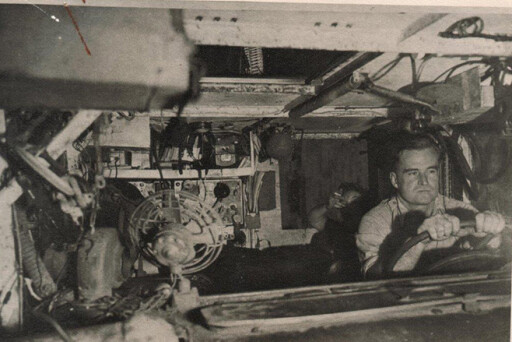 Australian newspapers only briefly mentioned Ben’s exploits. Even when Ben arrived in Canberra in November 1955, the headline on page two read: “Crazy Carlins’ drive into Canberra in their Amphibious jeep.”
Australian newspapers only briefly mentioned Ben’s exploits. Even when Ben arrived in Canberra in November 1955, the headline on page two read: “Crazy Carlins’ drive into Canberra in their Amphibious jeep.”
But nothing could deter Ben – not public scorn, ridicule, money or mechanical problems. Even bandits and hurricanes were no match for him.
The story began when Ben, a past student of Perth’s Guildford Grammar School, was demobbed from the Indian Army after the end of World War II. In March 1946, still in India, he saw his first amphibious jeep and casually said to his mate that with a bit of titivation the jeep could go around the world.
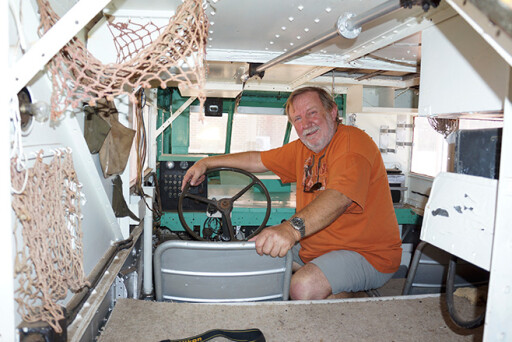 The amphibious jeep was a Ford GPA Seep (Seep is an acronym for seagoing jeep). It was hardly a successful design – it was heavy and slow on land with a low water line and a small cargo capacity.
The amphibious jeep was a Ford GPA Seep (Seep is an acronym for seagoing jeep). It was hardly a successful design – it was heavy and slow on land with a low water line and a small cargo capacity.
Many Seeps reportedly sank in minor chop and, of the original order of around 10,000, only about 5,000 were built during World War II. Most were relegated to crossing the placid streams of Europe and Russia.
By late 1946, and now in the USA, Ben found and bought a Seep and started to modify it; adding a bow, a superstructure with an enclosed cabin and a belly tank for the estimated 500 gallons (2273 litres) of fuel required for crossing the Atlantic Ocean. He dubbed the Seep Half-Safe.
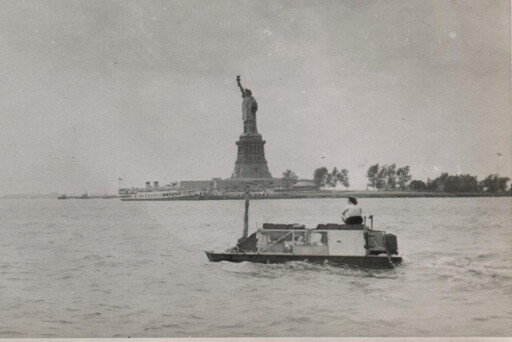 The first crossing attempt was in 1948, but grief struck just days out of New York – only 500km offshore. Ben, his wife Elinore, and a drifting Half-Safe, were picked up by an oil tanker. They tried again the following spring, this time from Halifax, Nova Scotia in Canada. This attempt was made without a belly tank, instead towing two tanks made from war surplus aircraft wing tanks. The tanks broke free and the couple had to chug back to Halifax.
The first crossing attempt was in 1948, but grief struck just days out of New York – only 500km offshore. Ben, his wife Elinore, and a drifting Half-Safe, were picked up by an oil tanker. They tried again the following spring, this time from Halifax, Nova Scotia in Canada. This attempt was made without a belly tank, instead towing two tanks made from war surplus aircraft wing tanks. The tanks broke free and the couple had to chug back to Halifax.
After designing and building a new tow-tank, the intrepid duo set off once more from Halifax on July 19, 1950. This time they had 730 gallons of fuel, 30 gallons of water, eight gallons of oil and enough food to last six weeks. Setting watches through the day and night the two alternated driving the craft toward the distant Azorean Islands. The conditions were cramped and the cabin was swimming with exhaust and petrol fumes; no wonder Elinore was seasick for days on end.
Every three days, fuel had to be transferred from the tow-tank to the jeep’s bow tank, which was a tricky operation. Servicing and oil changes were also common necessities. On day 11 the engine broke down and Ben was forced to remove the head, regrind the valves and put it back together again – all as waves pounded Half-Safe.
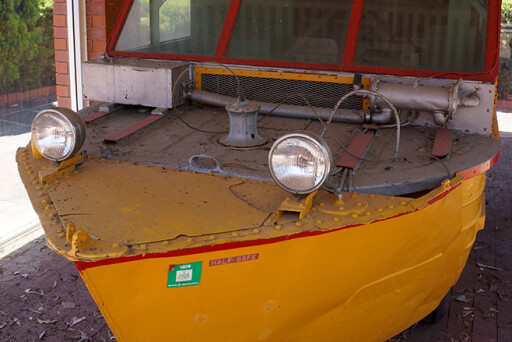 Still, after a few more dramas, mechanical issues and stormy seas, they arrived after 32 days at Flores, the western-most island of the Azores. Here, the happy couple thought their biggest hurdle was over but little did they know, there was plenty more to come.
Still, after a few more dramas, mechanical issues and stormy seas, they arrived after 32 days at Flores, the western-most island of the Azores. Here, the happy couple thought their biggest hurdle was over but little did they know, there was plenty more to come.
They spent two months on the island resting and repairing Half-Safe. After two false starts, they finally set off for Africa, estimated to be an easy 10 days away. When they hit the 10 day mark, with just a hand bilge pump working, they ran into a hurricane which pounded them and swept them off course. Somehow the little craft survived and on December 11 they arrived at Funchal, the capital of the Madeira Islands – and still more than 600km from Africa.
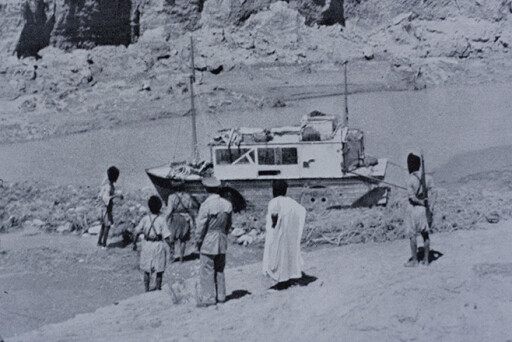 On the next leg they lost their tow-tank and had to divert to the Canary Islands for fuel. But as Ben reports in his book: “This 295-mile run was a catwalk.” So too was the remaining 75 miles to Africa, where they drove Half-Safe up the hard-packed sands of the small town of Cape Juby in, what was then, Spanish Morocco.
On the next leg they lost their tow-tank and had to divert to the Canary Islands for fuel. But as Ben reports in his book: “This 295-mile run was a catwalk.” So too was the remaining 75 miles to Africa, where they drove Half-Safe up the hard-packed sands of the small town of Cape Juby in, what was then, Spanish Morocco.
They left Cape Juby and headed north across a trackless section of the Sahara. Five days later they arrived at the Spanish fort of Tan-Tan where an earth road whisked them north, at an unprecedented 10mph, to the border and the French colony of Morocco.
On April 2, 1951 they crossed the Strait of Gibraltar to arrive in Europe and were met with a big dose of British bureaucracy. Over the next few years they worked, often apart, scraping together enough money to repair and modify Half-Safe for the next leg of the journey. In April 1955, they crossed the English Channel and headed across Europe. By the middle of May, they had crossed into Asia.
 Traversing the Middle East, Persia, Pakistan and then India, the couple were plagued by heat, humidity, border guards and police harassment. But apart from vapour locks stopping the engine on a regular basis, the little jeep’s standard 4-cylinder 2.2-litre petrol engine kept chugging away – they even attained speeds of up to 55mph on flat bitumen roads.
Traversing the Middle East, Persia, Pakistan and then India, the couple were plagued by heat, humidity, border guards and police harassment. But apart from vapour locks stopping the engine on a regular basis, the little jeep’s standard 4-cylinder 2.2-litre petrol engine kept chugging away – they even attained speeds of up to 55mph on flat bitumen roads.
In October 1955, they shipped the jeep from Calcutta to Perth and travelled across the Nullarbor to Melbourne, Canberra then Sydney and back again.
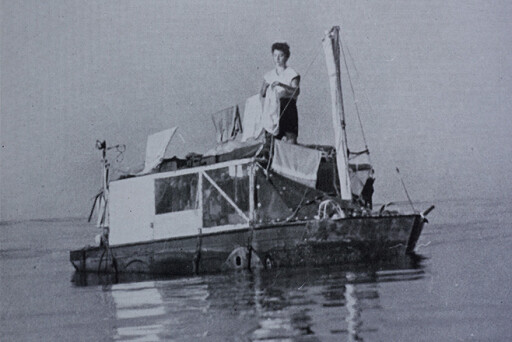 Elinore left Ben at this stage and while they were divorced some years later, they remained good friends for the rest of their lives. Ben went in search of a companion and Barry Hanley, a Perth local, took up the challenge.
Elinore left Ben at this stage and while they were divorced some years later, they remained good friends for the rest of their lives. Ben went in search of a companion and Barry Hanley, a Perth local, took up the challenge.
In February 1956, Ben’s world voyage recommenced in Calcutta. He immediately set sail down the river and across the Bay of Bengal to Rangoon, where Hanley joined up. For the next nine months, the two sweated and strained to get Half-Safe through the most demanding country it had tackled yet. The crossing of the mountains, from Moulmein in Burma (now Myanmar) to Siam (now Thailand), was so tough that Ben stated he’d rather recross the Atlantic twice than tackle those mountains again.
 Getting bogged in the swamps and jungles was common on their way north through Thailand, and the relatively new independent countries of Cambodia and Vietnam. Bandits were a problem on these lands, while on water they had pirates to contend with.
Getting bogged in the swamps and jungles was common on their way north through Thailand, and the relatively new independent countries of Cambodia and Vietnam. Bandits were a problem on these lands, while on water they had pirates to contend with.
Across the South China Sea, the engine valves again needed regrinding which was achieved with a double dose of seasickness tablets to help overcome the nausea of working head down in a petrol and oil filled engine compartment. On top of this, the Seep bobbed around in a tropical sea and it was hot and humid.
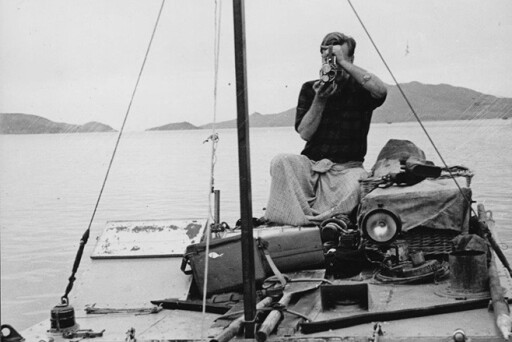 On May 5 the two arrived in Hong Kong, then sailed to Taiwan and onto Okinawa where the jeep almost collided with jagged coral reef. On the evening of July 24, 1956 they arrived in the southern Japanese port of Kagoshima.
On May 5 the two arrived in Hong Kong, then sailed to Taiwan and onto Okinawa where the jeep almost collided with jagged coral reef. On the evening of July 24, 1956 they arrived in the southern Japanese port of Kagoshima.
As they drove, and island hopped north, the little jeep again needed major maintenance. But in Japan, at that time, the sale of jeep parts to a civilian was banned. Ben managed to get around this problem by swapping parts.
In January 1957, Barry left Half-Case to live in Japan and Ben advertised for a companion for the last sea crossing. This time an American filled the void – Boye Lafayette De Mente, aka ‘Jingo’, who wanted to escape from two Japanese girlfriends.
 On May 3 they left Tokyo for Wakkanai, the northern most port on the island of Hokkaido. By now the press was keenly interested and Ben was kept busy speaking at many different events. But the jeep was feeling the pressure of the odyssey; break-downs were becoming more common, it was burning more fuel and the bilge required pumping every 20 minutes.
On May 3 they left Tokyo for Wakkanai, the northern most port on the island of Hokkaido. By now the press was keenly interested and Ben was kept busy speaking at many different events. But the jeep was feeling the pressure of the odyssey; break-downs were becoming more common, it was burning more fuel and the bilge required pumping every 20 minutes.
Still, on June 12 they set sail from northern Japan, towing a large tank of fuel once more, and headed towards the Aleutian Islands – this archipelago is mainly Alaskan land and divides the Pacific Ocean from the Bering Sea.
Battling wind, huge seas and the intimidating cold of these northern latitudes, the jeep paddled onwards but again mechanical issues – a fuel pump repair, and yet another valve grind – stymied their progress with an average speed of just over one knot. At one stage Ben was forced overboard to cut a rope free from the prop and was dragged from the near freezing water almost unconscious. Still, they arrived at Dutch Harbour, a major outpost of civilisation on the island chain on August 8.
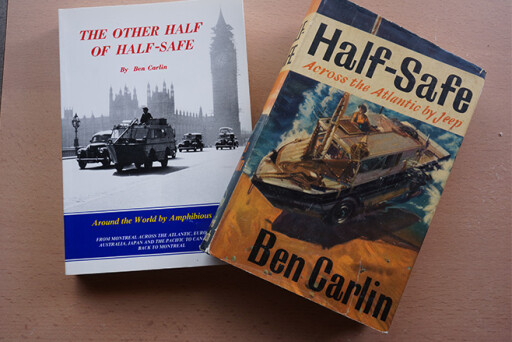 On September 2, 1957, Half-Case made its final landfall as it came ashore at Kenai, south of Anchorage in Alaska. It should have been the pinnacle of his adventure, but in Ben’s words he was flatter than “the bottom of the Grand Canyon. With no more oceans to cross, my life was ended.”
On September 2, 1957, Half-Case made its final landfall as it came ashore at Kenai, south of Anchorage in Alaska. It should have been the pinnacle of his adventure, but in Ben’s words he was flatter than “the bottom of the Grand Canyon. With no more oceans to cross, my life was ended.”
It was in Anchorage where he met another great Australian adventurer, Sir Hubert Wilkins. Ben was quickly dragged from his depression as he went from party to party.
Jingo flew home from Anchorage, seemingly not too impressed with Ben’s manner or temperament. Ben, in the meantime, managed to tear himself away from the parties and dinners, and on October 12 he headed out onto the Alcan Highway. This route south is considered by many travellers to be an adventure route, especially in those days when little of the 2000-odd kilometres was bitumen; but to Ben, it was easy.
 On December 7, Half-Safe was driven into Los Angeles and Ben spent the next four months trying to ignite interest in his exploits and the film he had shot. On April 16 he gave up on this and headed east to Montreal, where the trip had begun 10 years previously. As he drove in to the original starting point, Ben recalled it was: “To the roars of my own applause.”
On December 7, Half-Safe was driven into Los Angeles and Ben spent the next four months trying to ignite interest in his exploits and the film he had shot. On April 16 he gave up on this and headed east to Montreal, where the trip had begun 10 years previously. As he drove in to the original starting point, Ben recalled it was: “To the roars of my own applause.”
To this day, Ben managed to pull off an incredible adventure that has never been repeated.

COMMENTS